MyBatis - 1.2
Extension ID
com.castsoftware.ibatis
What’s new ?
See Release Notes.
Description
This extension provides support for:
- MyBatis for Java using:
- Mapper XML file containing SQL queries
- MyBatis Annotations for JAVA
- MyBatis-Spring integration
- MyBatis for .NET using:
- Mapper XML file containing SQL queries only
- TkMyBatis using:
- Methods provided by mapper class
In what situation should you install this extension?
This extension should be installed when analyzing a Java/.NET project that uses a MyBatis framework or TkMyBatis framework, and you want to view a transaction consisting of MyBatis objects with their corresponding links. Links to corresponding database tables can also be resolved, provided that the SQL database has been extracted and DDL has been created.
Supported MyBatis versions
| Language Supported | Version | Support |
|---|---|---|
| Java | 3.4.0 | Mapper XML files«br>MyBatis Annotation for Java MyBatis-Spring Integration |
| .NET | 4.5.2 | Mapper XML file |
Supported TkMyBatis Libraries
| Library | Version |
|---|---|
| mapper-spring-boot-starter | 2.1.5 |
Supported TkMyBatis Operations
| Operation | Methods |
|---|---|
| Insert | insert |
| Insert | insertSelective |
| Update | updateByExample |
| Insert | updateByExampleSelective |
| Insert | updateByPrimarykey |
| Insert | updateByPrimaryKeySelective |
| Select | select |
| Select | selectAll |
| Select | selectByExample |
| Select | selectByExampleAndRowBounds |
| Select | selectByPrimaryKey |
| Select | selectByRowBounds |
| Select | selectCount |
| Select | selectCountByExample |
| Select | selectOneByExample |
| Select | selectOne |
| Delete | delete |
| Delete | deleteByExample |
| Delete | deleteByPrimaryKey |
Function Point, Quality and Sizing support
- Function Points (transactions): a green tick indicates that OMG Function Point counting and Transaction Risk Index are supported
- Quality and Sizing: a green tick indicates that CAST can measure size and that a minimum set of Quality Rules exist
| Function Points (transactions) | Quality and Sizing |
|---|---|
| ✅ | ❌ |
Compatibility
| Release | Operating System | Supported |
|---|---|---|
| v3/8.4.x | Microsoft Windows / Linux | ✅ |
| v2/8.3.x | Microsoft Windows | ✅ |
Dependencies with other extensions
Some extensions require the presence of other extensions in order to function correctly. The MyBatis extension requires that the following other CAST extensions are also installed:
- CAST AIP Internal extension (internal technical extension)
- SQL Analyzer extension
Download and installation instructions
The extension will be automatically downloaded and installed.
Source code discovery
The MyBatis extension does not contain any discoverers or extractors, therefore, no “MyBatis” projects will be discovered. However, since the code delivered is Java/.NET and SQL, when using AIP Console, all source should be detected automatically. You should therefore ensure that your code is organised as follows before delivery:
Java
- one folder containing all the Java related code along with MyBatis.
- one folder containing the SQL DDL extraction
.NET
- one folder containing all the .NET related code and the XML related files
- one folder containing the SQL DDL extraction
Delivery and analysis configuration
After delivery you should end up with the following technologies:
- JEE or .NET for the main source code
- Universal for the SQL source code
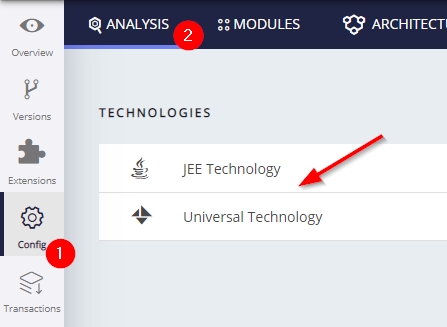
All dependencies will be automatically configured (example for JEE):
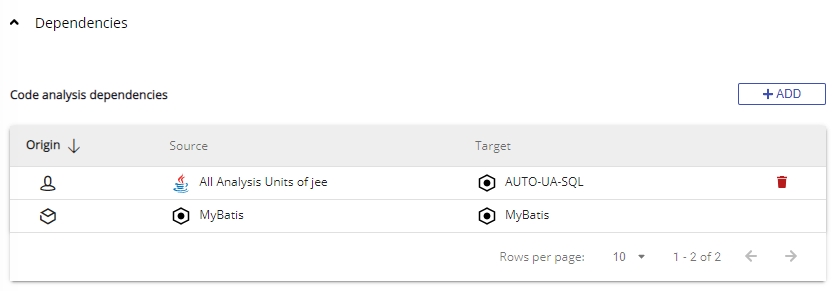
Note that:
- When working with .NET, the package discovered is equivalent to the main source code package described in .NET - Prepare and deliver the source code.
- you may need to create additional packages, for example, for .NET an additional package may be required to package the .NET Assemblies. Please refer to .NET - Prepare and deliver the source code.
What results can you expect?
Once the analysis/snapshot generation has completed, you can view the results in the normal manner. Below are the transactions obtained after analysis as shown in CAST Enlighten:
For Java
Mapper XML files
For Mapper XML files - this extension will detect SQL queries and create objects and links. Below is a Mapper XML file with its result in Enlighten:

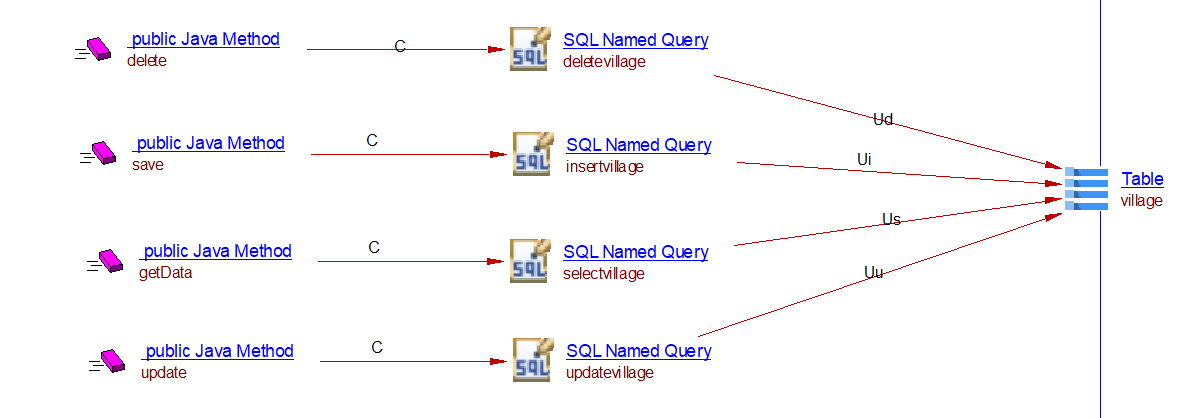
Support of “Include” tag
This extension provide support of “Include” tag used in Mapper XML file. Below is a sample of “Include” tag with its result in Enlighten:


Support of Dynamic SQL Tags
This extension provide support of following Dynamic SQL tag used in Mapper XML file. Below is list of tags support with sample source code and result in Enlighten:
| Element | Description |
|---|---|
| isEmpty | Checks to see if the value of a Collection, String property is null or empty. |
| isNotEmpty | Checks to see if the value of a Collection, String property is not null and not empty. |
| isNotNull | Checks if a property is not null. |
| isNull | Checks if a property is null. |
| isPropertyAvailable | Checks if a property is available. |
| isNotPropertyAvailable | Checks if a property is unavailable. |
| isParameterPresent | Checks to see if the parameter object is present (not null). |
| isNotParameterPresent | Checks to see if the parameter object is not present (null). |
| isEqual | Checks the equality of a property and a value, or another property. |
| isNotEqual | Checks the inequality of a property and a value, or another property. |
| isGreaterThan | Checks if a property is greater than a value or another property. |
| isGreaterEqual | Checks if a property is greater than or equal to a value or another property. |
| isLessEqual | Checks if a property is less than or equal to a value or another property. |

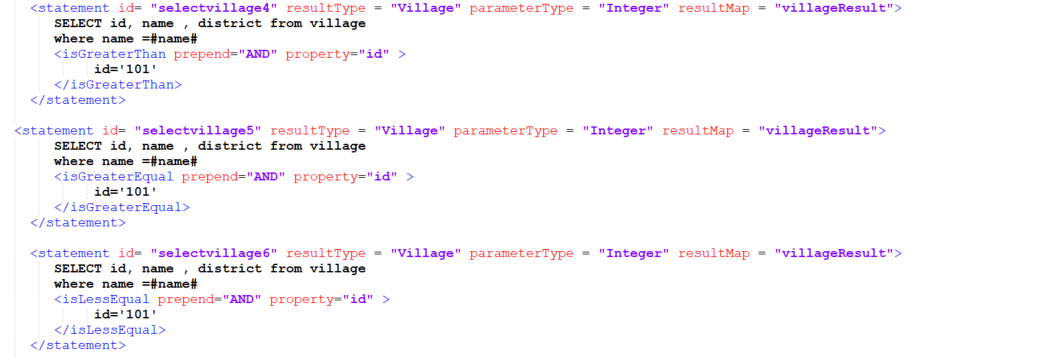
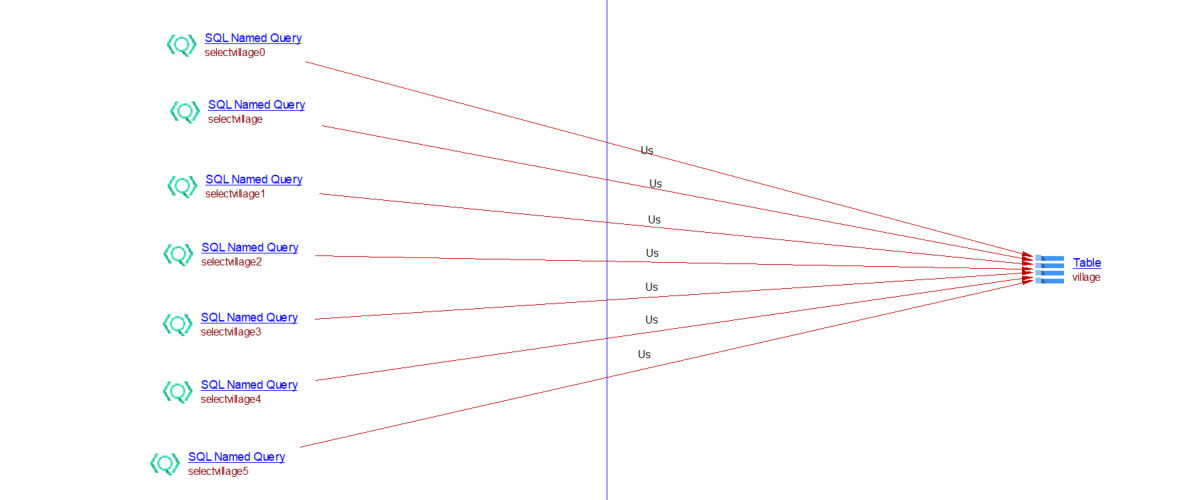
list of Add-on Dynamic SQL tags support with sample source code and result in Enlighten:
| Tags |
| where |
| foreach |
| if |
<select id="getSelectVillage" resultMap="SelectVillage">
select ID,Name,district from Village
<where>
file.ID in
<foreach collection="interNames" item="interName">#{interName}</foreach>
<if test="District != null and !District.isEmpty">
and District in
<foreach collection="District" item="district" open="(" separator="," close=")">#{district}</foreach>
</if>
</where>
group by ID
) as import_errors
on persist_errors.ID = import_errors.ID
</select>

MyBatis for Annotation / MyBatis-Spring Integration
Supported Annotations
This extension supports the following Annotations used in MyBatis Annotations for Java and MyBatis-Spring integration applications:
-
@Select - org.apache.ibatis.annotations.Select
-
@Insert - org.apache.ibatis.annotations.Insert
-
@Update - org.apache.ibatis.annotations.Update
-
@Delete - org.apache.ibatis.annotations.Delete
For MyBatis Annotations
In Java mapper File, when we pass the SQL Queries with annotation parameter directly. Below is a MyBatis-Annotation sample source code with its result in Enlighten


In the Java Mapper file, when the annotation parameter contains variables which are initialized with a query instead of a query statement itself. Below is a sample source code with its result in Enlighten:


For MyBatis-Spring
Below a Mybatis Spring Integration sample source code with its result in Enlighten:
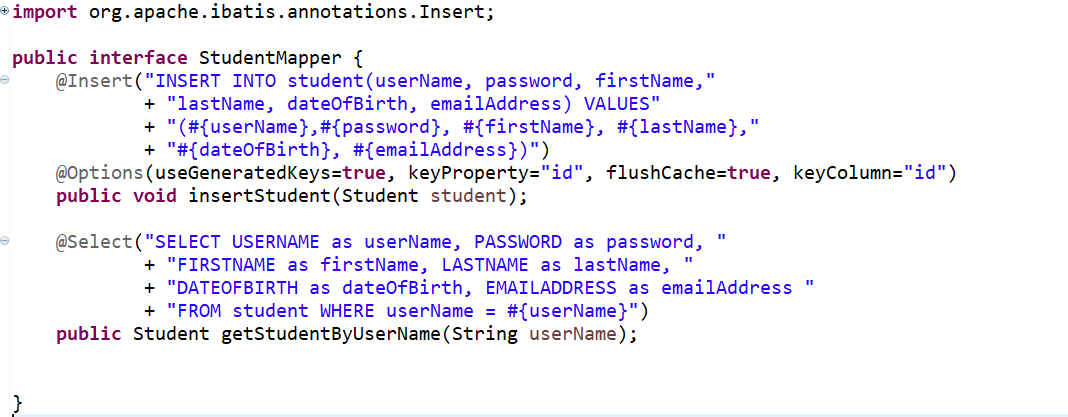

For .NET
For Mapper XML files, below is a mapper XML file with its result in Enlighten:
MYBATIS DOTNET SQLNAMEDQUERY are created to link between C# method and tables
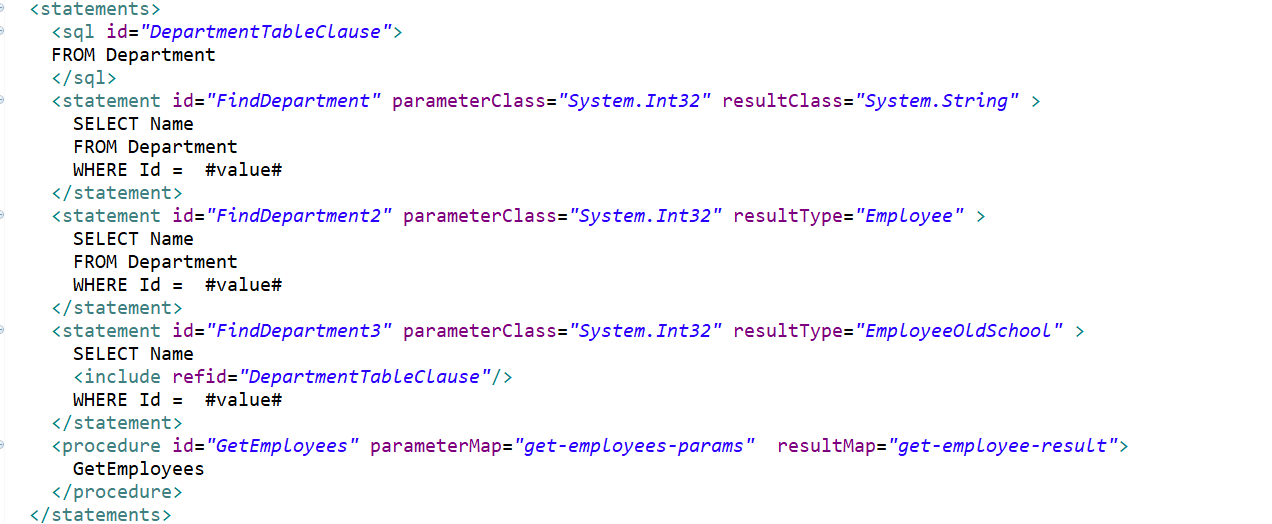
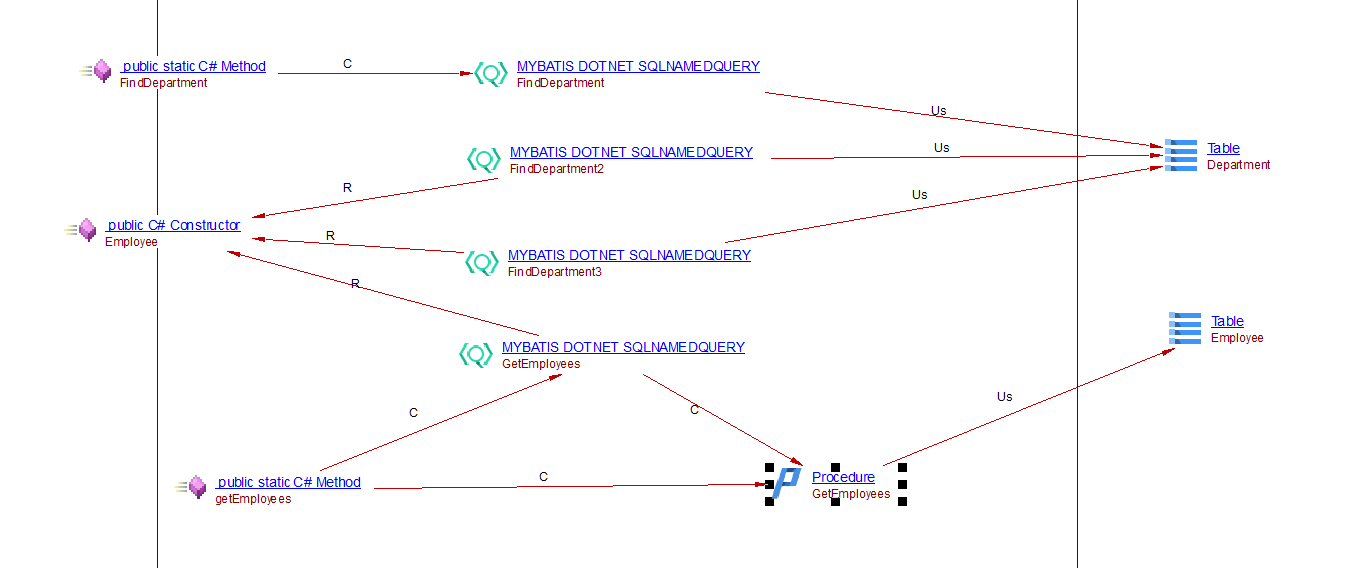
For TkMyBatis
TkMyBatis source code scenario - 1
Insert operation:
public int addVillageCore(VillagePropertysTypeDao card) throws IOException
{
int chck = villagePropertysTypeDao.insertSelective(entity);
return chck;
}

Select operation:
private List<VillagePropertysTypeDTO> getVillagePropertysTypeAll() {
return VillageNameutil.get("VillagePropertysType_All", new Callable<List<VillagePropertysTypeDTO>>() {
public List<VillagePropertysTypeDTO> call() throws IOException {
var list = villagePropertysTypeDao.selectAll();
return Districtvillageutil.copyList(list, VillagePropertysTypeDTO.class);
}
});
}

Update operation:
public int updateVillageCore(villageEntity entity) {
entity.setModifyTime(new Date());
entity.setVillageID(null);
entity.setName(null);
return villagePropertysTypeDao.updateByExampleSelective(entity,example);
}

TkMyBatis source code scenario - 2
A quick introduction of how to create the project with its result in Enlighten:
Configuration Entity class:
@Table(name = "`village`")
public class Village_data
{
.....
}
Create the interface:
import tk.mybatis.mapper.common.Mapper;
@Component
public interface VillageDao<T> extends Mapper<T>{
}
Create the DAO interface:
public interface VillagePropertysTypeDao extends VillageDao<Village_data>{
}
Test case - Use of Interface:
public List<VillagePropertysTypeDTO> getVillagePropertysCore(String memberId) {
var queryVillage = new Village_data();
queryVillage.setMemberID(memberId);
var list = villagePropertysTypeDao.selectByRowBounds(queryVillage);
return BeanUtil.copyList(list, VillagePropertysTypeDTO.class);
}

Objects
The following specific objects are displayed in CAST Enlighten:
- Mapper xml file - this object is created by the JEE Analyzer/.NET Analyzer.
- SQL_Named query - this object(s) is created by the MyBatis extension for Java Projects.
- MYBATIS DOTNET SQLNAMEDQUERY - this object(s) is created by the MyBatis extension for .NET Projects.
Links
Various links are created but the following are the links specific to the MyBatis extension:
MyBatis for Java
- Call link between a Java Method object and an SQL_Named query object.
- Use (typed with Select, Delete, Insert, Update) link between an SQL_Named query object and a Table object.
MyBatis for .NET
- Call link between a .NET Method object and an MYBATIS DOTNET SQLNAMEDQUERY object.
- Use (typed with Select, Delete, Insert, Update) link between an MYBATIS DOTNET SQLNAMEDQUERY object and a Table object.
- Refer link between a .NET Constructor object and an MYBATIS DOTNET SQLNAMEDQUERY object.
TkMyBatis
- Use (typed with Select, Delete, Insert, Update) link between an Java Method object and a Table object.
public int addUpdateVillageCore(VillagePropertysTypeDao card) throws IOException
{
Village_data entity =new Village_data();
int chck = villagePropertysTypeDao.insertSelective(entity);
var type = new typed(Village_data.class);
entity.setModifyTime(new Date());
entity.setVillageID(null);
entity.setName(null);
return villagePropertysTypeDao.updateByExampleSelective(entity,type);
}

Structural Rules
The following structural rules are provided with MyBatis extension: